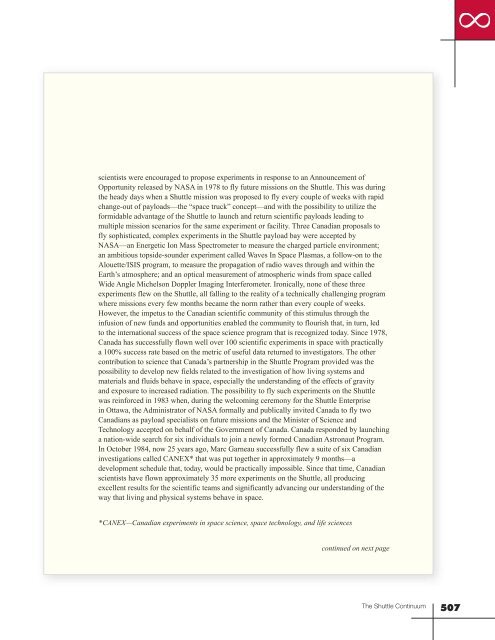Social, Cultural and Educational Legacies - ER - NASA
Social, Cultural and Educational Legacies - ER - NASA
Social, Cultural and Educational Legacies - ER - NASA
You also want an ePaper? Increase the reach of your titles
YUMPU automatically turns print PDFs into web optimized ePapers that Google loves.
scientists were encouraged to propose experiments in response to an Announcement ofOpportunity released by <strong>NASA</strong> in 1978 to fly future missions on the Shuttle. This was duringthe heady days when a Shuttle mission was proposed to fly every couple of weeks with rapidchange-out of payloads—the “space truck” concept—<strong>and</strong> with the possibility to utilize theformidable advantage of the Shuttle to launch <strong>and</strong> return scientific payloads leading tomultiple mission scenarios for the same experiment or facility. Three Canadian proposals tofly sophisticated, complex experiments in the Shuttle payload bay were accepted by<strong>NASA</strong>—an Energetic Ion Mass Spectrometer to measure the charged particle environment;an ambitious topside-sounder experiment called Waves In Space Plasmas, a follow-on to theAlouette/ISIS program, to measure the propagation of radio waves through <strong>and</strong> within theEarth’s atmosphere; <strong>and</strong> an optical measurement of atmospheric winds from space calledWide Angle Michelson Doppler Imaging Interferometer. Ironically, none of these threeexperiments flew on the Shuttle, all falling to the reality of a technically challenging programwhere missions every few months became the norm rather than every couple of weeks.However, the impetus to the Canadian scientific community of this stimulus through theinfusion of new funds <strong>and</strong> opportunities enabled the community to flourish that, in turn, ledto the international success of the space science program that is recognized today. Since 1978,Canada has successfully flown well over 100 scientific experiments in space with practicallya 100% success rate based on the metric of useful data returned to investigators. The othercontribution to science that Canada’s partnership in the Shuttle Program provided was thepossibility to develop new fields related to the investigation of how living systems <strong>and</strong>materials <strong>and</strong> fluids behave in space, especially the underst<strong>and</strong>ing of the effects of gravity<strong>and</strong> exposure to increased radiation. The possibility to fly such experiments on the Shuttlewas reinforced in 1983 when, during the welcoming ceremony for the Shuttle Enterprisein Ottawa, the Administrator of <strong>NASA</strong> formally <strong>and</strong> publically invited Canada to fly twoCanadians as payload specialists on future missions <strong>and</strong> the Minister of Science <strong>and</strong>Technology accepted on behalf of the Government of Canada. Canada responded by launchinga nation-wide search for six individuals to join a newly formed Canadian Astronaut Program.In October 1984, now 25 years ago, Marc Garneau successfully flew a suite of six Canadianinvestigations called CANEX* that was put together in approximately 9 months—adevelopment schedule that, today, would be practically impossible. Since that time, Canadianscientists have flown approximately 35 more experiments on the Shuttle, all producingexcellent results for the scientific teams <strong>and</strong> significantly advancing our underst<strong>and</strong>ing of theway that living <strong>and</strong> physical systems behave in space.*CANEX—Canadian experiments in space science, space technology, <strong>and</strong> life sciencescontinued on next pageThe Shuttle Continuum507
















